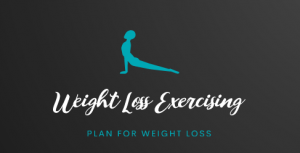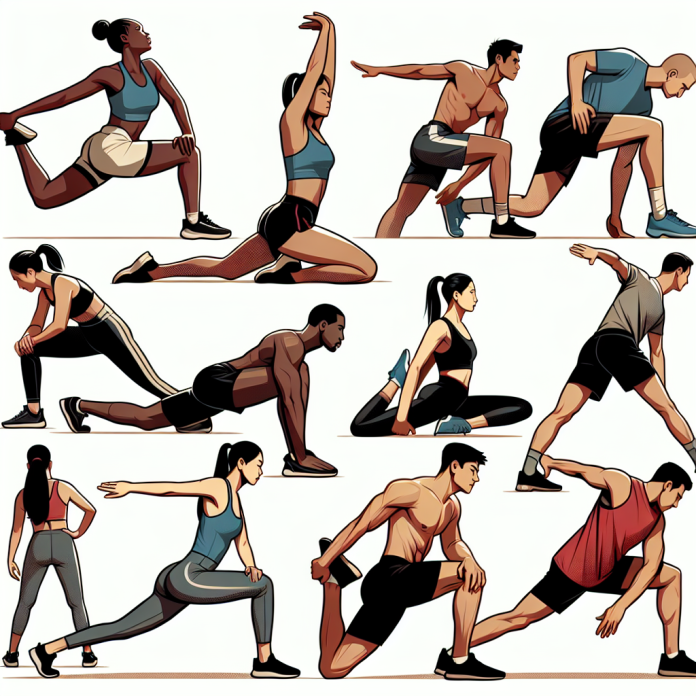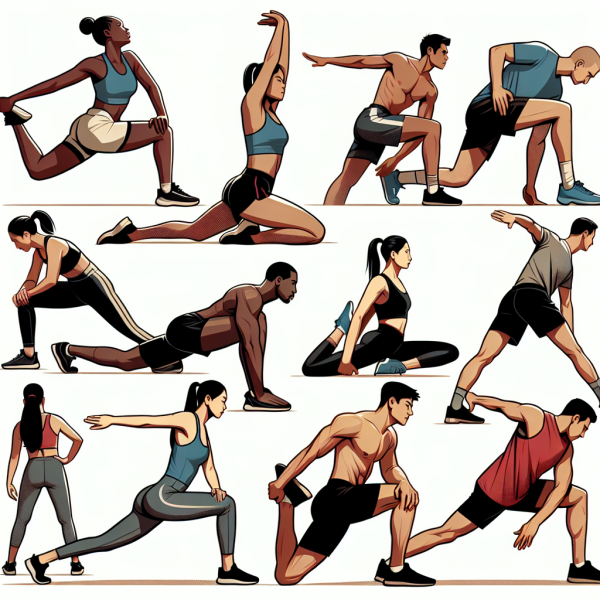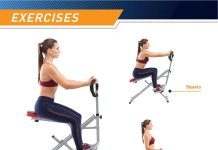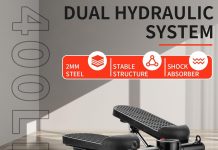If you’ve ever felt like your body could use a little extra flexibility, then look no further! In this article, we’re going to talk about the wonderful world of stretching exercises for flexibility. Whether you’re an athlete looking to improve your performance or simply wanting to touch your toes without feeling like a contortionist, we’ve got you covered. With a variety of stretches targeting different areas of the body, you’ll be amazed at how these exercises can help you become more limber in no time. So let’s dive in and get ready to stretch our way to increased flexibility!
Review contents
Benefits of Stretching Exercises
Improved Flexibility
Stretching exercises can significantly improve your flexibility, allowing you to move more freely and with greater ease. By performing different stretching techniques regularly, you can increase the flexibility of your muscles and joints, enabling you to perform various activities and exercises with a wider range of motion.
Increased Range of Motion
Along with improved flexibility, stretching exercises also help to increase your range of motion. This means that you will be able to move your joints through a larger range, enabling you to perform daily tasks more efficiently and comfortably. Whether it’s reaching for something on a high shelf or bending down to tie your shoe, having an increased range of motion can greatly enhance your overall mobility.
Enhanced Performance
Stretching exercises have been shown to enhance athletic performance in various sports and physical activities. By improving flexibility, stretching helps to optimize muscle function and efficiency during movements, leading to better overall performance. Additionally, stretching can help to prevent muscle imbalances and correct postural issues, both of which can contribute to improved performance in sports and everyday activities.
Reduced Risk of Injury
Regular stretching can help to reduce the risk of injuries by improving the flexibility and elasticity of your muscles and connective tissues. When your muscles are flexible, they are less prone to strains, tears, and other types of injuries. Stretching exercises also help to improve blood circulation and promote proper alignment and balance, further reducing the risk of falls and other accidents.
Types of Stretching Exercises
Static Stretching
Static stretching is a popular and widely known stretching technique that involves holding a stretch position for a prolonged period, usually around 30 seconds. This type of stretching is often performed after a workout or any activity that involves physical exertion. Static stretches target specific muscles or muscle groups and promote relaxation and recovery.
Dynamic Stretching
Dynamic stretching is a more active form of stretching that involves moving parts of your body through a full range of motion. Unlike static stretching, dynamic stretching is typically performed before a workout or physical activity to warm up the muscles and prepare them for movement. Dynamic stretches help to increase blood flow, flexibility, and overall body temperature.
Active Isolated Stretching
Active isolated stretching (AIS) is a stretching technique that involves holding a stretch for only 1-2 seconds and then releasing the stretch. This type of stretching targets specific muscles or muscle groups and is performed in a repetitive and controlled manner. AIS helps to improve joint mobility, flexibility, and circulation.
Proprioceptive Neuromuscular Facilitation (PNF) Stretching
PNF stretching is a highly effective stretching technique that involves a combination of stretching and contracting muscles. It typically requires a partner or a resistance device. PNF stretching is based on the concept of alternating muscle contractions and relaxations, which allows for a greater stretch and improved flexibility. This technique is often used in rehabilitation settings to improve range of motion and muscle strength.
Ballistic Stretching
Ballistic stretching involves bouncing or repetitive movements to take a muscle beyond its normal range of motion. While this type of stretching can be effective in improving flexibility, it is also associated with a higher risk of injury. Therefore, it is important to approach ballistic stretching with caution and only perform it under the guidance of a qualified professional.
Static Stretching
Technique
To perform static stretching, simply take a muscle or muscle group to the point of tension and hold the stretch for about 30 seconds. Make sure to breathe deeply and relax into the stretch. Avoid bouncing or jerking movements, as they can lead to injury. It is important to note that static stretching should be done when your muscles are warm, such as after a workout, to achieve optimal results.
Common Static Stretching Exercises
Some common static stretching exercises include:
- Hamstring stretch: Sit on the ground with one leg extended in front of you and the other bent with the sole of your foot against your inner thigh. Reach for your extended leg and hold the stretch.
- Quadriceps stretch: Stand upright, reach back and grab your ankle, and gently pull your heel towards your glutes while keeping your knees close together.
- Chest stretch: Stand with your feet shoulder-width apart, interlock your fingers behind your back, and gently lift your arms up and away from your body.
Precautions
While static stretching can be beneficial, it is important to be cautious and avoid overstretching. Never push yourself to the point of pain, as this can lead to injury. Additionally, it is important to perform static stretching on both sides of your body to maintain balance and symmetry.
Dynamic Stretching
Technique
To perform dynamic stretching, use controlled and fluid movements to take your joints and muscles through a full range of motion. Start with smaller movements and gradually increase the range of motion as your muscles warm up. Dynamic stretching should be performed in a smooth and controlled manner, without jerking or bouncing movements.
Common Dynamic Stretching Exercises
Some common dynamic stretching exercises include:
- Arm circles: Stand with your feet shoulder-width apart and extend your arms out to the sides. Make small circles with your arms and gradually increase the size of the circles.
- Walking lunges: Take a step forward with your right foot and lower your body into a lunge position. Push off with your right foot and repeat the movement with your left foot.
- High knees: Stand upright and jog in place while lifting your knees as high as possible with each step.
Precautions
When performing dynamic stretching, it is important to listen to your body and avoid any movements that cause pain or discomfort. Start slowly and gradually increase the intensity and speed of your movements. If you have any existing injuries or medical conditions, consult with a healthcare professional before attempting dynamic stretching.
Active Isolated Stretching
Technique
Active isolated stretching involves holding a stretch for 1-2 seconds and then releasing it. This type of stretching is typically done in a repetitive manner, with multiple repetitions for each muscle or muscle group. To perform active isolated stretching, move the muscle to its fullest range of motion and hold the end position for a brief moment, then release the stretch and repeat.
Common Active Isolated Stretching Exercises
Some common active isolated stretching exercises include:
- Calf stretch: Stand facing a wall with one foot slightly behind the other. Lean forward and place your hands on the wall, keeping your back leg straight and your front knee slightly bent. Hold the stretch for 1-2 seconds and then release.
- Shoulder stretch: Stand upright with your feet shoulder-width apart. Extend one arm across your body and use your other arm to gently pull the extended arm closer to your chest. Hold for 1-2 seconds and then release.
Precautions
While active isolated stretching can be beneficial, it is important to avoid excessive stretching or jerky movements that can lead to injury. Listen to your body and only stretch to the point of tension, without causing pain. If you have any medical conditions or injuries, consult with a healthcare professional before attempting active isolated stretching.
Proprioceptive Neuromuscular Facilitation (PNF) Stretching
Technique
PNF stretching involves a combination of stretching and contracting muscles. It typically requires a partner or a resistance device, such as a stretching strap or resistance band. To perform PNF stretching, start by stretching the muscle or muscle group for about 10 seconds. Then, contract the muscle against the resistance for about 6-10 seconds. Finally, relax the muscle and stretch it again, this time achieving a greater range of motion.
Common PNF Stretching Exercises
Some common PNF stretching exercises include:
- Hamstring stretch: Lie on your back with one leg extended on the ground and the other leg extended upwards with a resistance band wrapped around your foot. Pull the resistance band towards your head, contracting your hamstring, and hold for 6-10 seconds. Relax and stretch the muscle further.
- Shoulder stretch: Stand upright with both arms extended straight in front of you, holding a resistance band. Pull the resistance band towards your body, contracting your shoulders, and hold for 6-10 seconds. Relax and stretch the muscles further.
Precautions
PNF stretching requires proper technique and guidance, especially when involving a partner or resistance device. It is important to communicate and coordinate with your partner to ensure safe and effective stretching. If you are unfamiliar with PNF stretching or have any medical conditions or injuries, it is recommended to consult with a healthcare professional or a qualified trainer before attempting PNF stretching.
Ballistic Stretching
Technique
Ballistic stretching involves bouncing or repetitive movements to take a muscle beyond its normal range of motion. This type of stretching uses the momentum of the movement to push the muscle further. To perform ballistic stretching, make quick and rhythmic bouncing movements that gradually increase the stretch. It is important to note that ballistic stretching should only be performed by individuals who have a high level of flexibility and under the guidance of a qualified professional.
Common Ballistic Stretching Exercises
Some common ballistic stretching exercises include:
- Leg swings: Stand next to a wall or support and swing one leg forward and backward in a controlled but dynamic motion. Gradually increase the height and speed of the swing to increase the stretch.
- Arm circles: Stand with your feet shoulder-width apart and extend your arms out to the sides. Make quick and rhythmic circular motions with your arms, gradually increasing the size of the circles.
Precautions
Ballistic stretching carries a higher risk of injury compared to other stretching techniques. It is important to approach ballistic stretching with caution and only perform it if you have a high level of flexibility and are properly warmed up. Individuals with limited flexibility or any existing injuries or conditions should avoid ballistic stretching altogether.
